Isis in England ©
The Genesis of Isis Went Everywhere
The Genesis of Isis reached England before the Celts, Anglos, Saxons, Romans, Christians, and Normans were there. "Old" Pagans of Assur's prehistoric empire were in England before the Genesis of Isis arrived there.
The legend of Assur and Isis is not just the foundation legend of Egypt. It is the foundation legend of the ancient Pagan world. It begins back at the melt down of the Ice Age. According to the Pagan foundation legend, Assur was the inventor of agriculture and animal husbandry. During the Ice Age, the culture of England was a typical hunting and foraging culture as had sustained humankind for as long as there have been humans. After the Ice Age thawed out, Assur's descendants introduced agriculture and animal husbandry into England as a cultural "package" from the east. That was the "old" Pagan culture of England.
(See the
Ice Age and
First Kingdom
pages on this website for a discussion concerning the meltdown of the Ice Age and the origins of human civilization.)
Assur and his descendants established a far-flung empire of related UrRean kingdoms in the prehistoric period following the melt down of the Ice Age. Upper Egypt and Lower Egypt were pre-Egyptian Nile River civilizations. They were two of the UrRean kingdoms of that prehistoric empire. Agriculture and animal husbandry were practiced in Upper Egypt, Lower Egypt, Hittani, Sumer, and in England, before the birth of Isis. "Old" Pagan England was another one of the UrRean kingdoms of the ancient UrRean empire. That ancient empire rose and fell before the birth of Isis. The "new" Pagans of England were minions of Isis disseminating the Genesis of Isis. They arrived in England after they had "resurrected" Egypt and other old Pagan UrRean kingdoms to the east of England.
(See the
Sunwing page on this web site for a discussion concerning the UrRean kings and their prehistoric kingdoms.)
Stonehenge and the pyramids of Egypt were built after the Genesis of Isis.
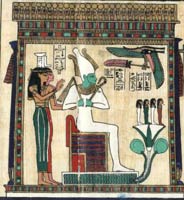
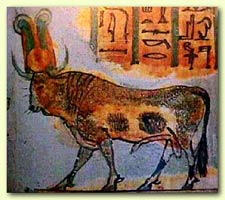 Egyptian images of the god Assur frequently show him colored green and holding a shepherd's crook and grain flail in his hands. The color green identifies him as the god of vegetation and the domesticator of plants. The crook and flail identifies him as the ancestral deity of shepherds and farmers. He is frequently depicted as a bull god, which identifies him as the ancestor of cattle based cultures.
Egyptian images of the god Assur frequently show him colored green and holding a shepherd's crook and grain flail in his hands. The color green identifies him as the god of vegetation and the domesticator of plants. The crook and flail identifies him as the ancestral deity of shepherds and farmers. He is frequently depicted as a bull god, which identifies him as the ancestor of cattle based cultures.
According to the legend of Assur and Isis, Assur was the founding king of the first kingdom on earth. After he had raised his own people up from savagery and ignorance he went about teaching the arts of civilization to the rest of the world. A company of evil conspirators murdered Assur. Isis resurrected Assur from the dead. She had union with her resurrected king. The world family bloodline of 'divine kings' who were 'descendants of the gods' began from the union of Isis and Assur.
Different versions of the Pagan foundation legend have come down to us from ancient times. The Biblical tale of Adam and Eve is one version of the Assur and Isis legend. All the versions of the foundation legend tell the story as the lives of two individuals in a single lifetime. However, an 8,000-10,000 year record of history is condensed into that simple story. Parts of the story relate to Assur's deeds shortly after the melt down of the Ice Age. Parts of the story, relate to travails of Queen Hatchepsut (c.1480 BC). Some of the prehistoric monuments of England were the works of the "old" Pagan culture there. Some of the most famous monuments were the later works of "new" Pagans of the Isis bloodline.
Mute stone monuments dot the English countryside.
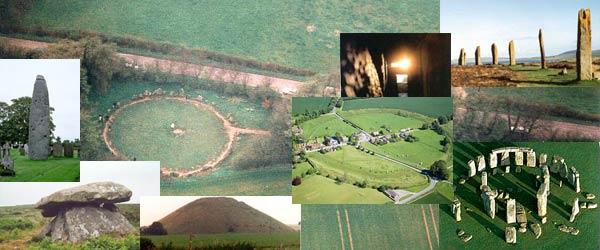
Language is culture. Every culture is embodied in the language it speaks. When a language is lost; that culture is lost. Mute stone monuments dot the English countryside. Their languages are lost, yet some of those mute stones speak. They say in the sign language of archaeology that their builders were farmers who had knowledge of astronomy. Their magnitude and permanence speak of our early ancestors' need for stability and order in a precarious and changing world.
During his raid on Celtic Britain in 55 B.C., Julius Caesar commented on its high population and numerous farms and cattle.
Caesar wrote that they:
"know much about the stars and celestial motions, and about the
size of the earth and universe, and about the essential nature of
things, and about the powers and authority of the immortal gods;
and these things they teach to their pupils."
Stonehenge is the most widely known of England's prehistoric monuments. Next to the pyramids of Egypt, Stonehenge may be the most famous prehistoric monument in the world.
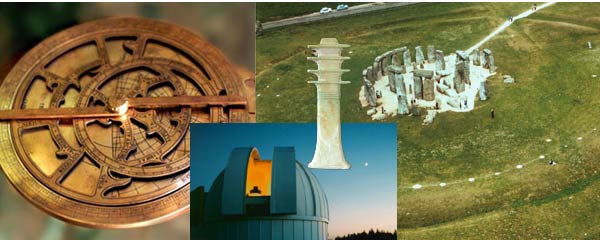
Stonehenge is the bony skeleton of an ancient wooden structure. It was an astronomical observatory. Ancient astronomers made their observations at the horizon. Stonehenge, like the fabled Tower of Babel, employed a false horizon elevated above the natural terrain to measure and record the movements of the heavens. Stonehenge probably employed several false horizons in concentric circles within the outer circle. The horizons were kept level by measuring up from water in a moat around the horizon. The moat around Stonehenge defines the size of the outer ring. On a ring of that size, the astronomers were able to make very accurate measurements despite the crudeness of their instrument.
(See Alphabet Page
I and the
Tower of Babel on this website for a further discussion of ancient astronomy.)
Stone circles may have been the ancient equivalent of city halls with clock towers.
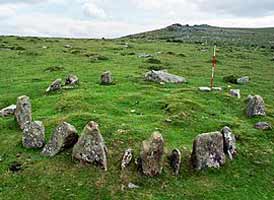
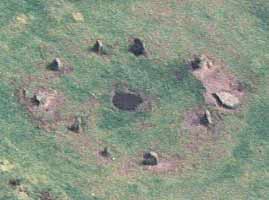 Hundreds of stone circles of lesser magnitude than Stonehenge dot the countryside of England and western Europe. Those were probably local calendars that served the people of a clan, settlement, or district. Each stone-circle calendar probably had an operator who moved marker stones around the circle to count off days and keep track of events such as festivals, clan gatherings, and meetings of governing council circles. The stone circles may have been the seats of government where the governing councils actually met. Every culture has some method of keeping time. In those circle-stone cultures, the position of timekeeper was probably a position of responsibility and prestige that carried considerable influence with it.
Hundreds of stone circles of lesser magnitude than Stonehenge dot the countryside of England and western Europe. Those were probably local calendars that served the people of a clan, settlement, or district. Each stone-circle calendar probably had an operator who moved marker stones around the circle to count off days and keep track of events such as festivals, clan gatherings, and meetings of governing council circles. The stone circles may have been the seats of government where the governing councils actually met. Every culture has some method of keeping time. In those circle-stone cultures, the position of timekeeper was probably a position of responsibility and prestige that carried considerable influence with it.
Assur and his descendants conquered and bred widely establishing the first kingdoms.
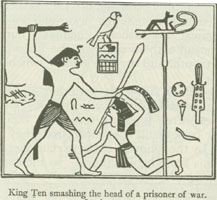
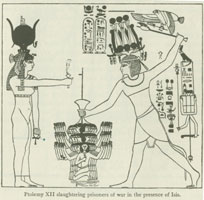
Assur and his descendants established a far-flung empire of related UrRean kingdoms in the prehistoric period following the melt down of the Ice Age. Prehistoric kings of Nile River civilizations, East African civilizations, Tigris and Euphrates River civilizations, Danube River civilizations, Hittite civilizations, Siam, China, and England, were "old" Pagans of that ancient UrRean empire.
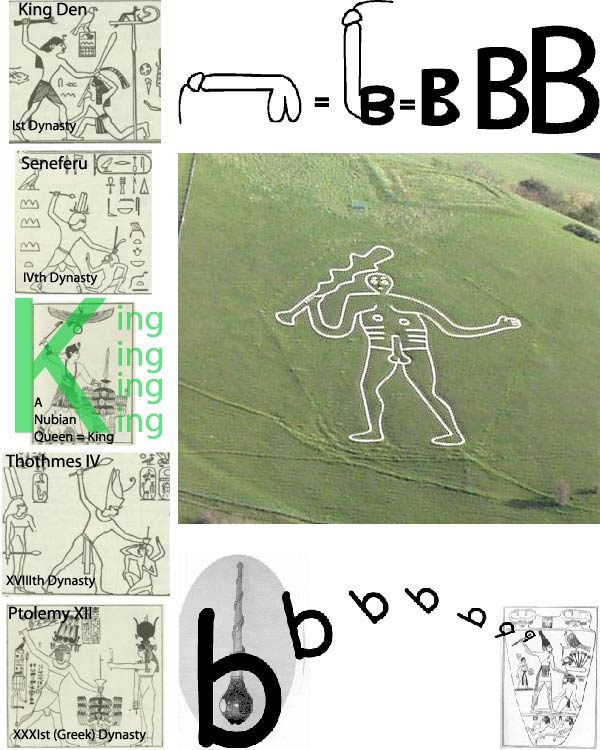
In Egyptian imagery, kings bashing the skulls of captives were common motifs from the First Dynasty to the last. The Cerne Giant is clearly a related work of art.
And it came to pass, when men began to multiply
on the face of the earth, and when daughters
were born unto them, that the sons of God saw
the daughters of men that they were fair; and they
took them wives of all which they chose. . . There were giants in the earth in those days; and also
after that, when the sons of God came in unto the daughters of men, and they bare children unto
them, the same became mighty men which were of old, men of renown.
Gen. 6: 1-4.
Those "mighty men which were of old" were Assur's descendants establishing the first kingdoms on earth. The Cerne Giant portrays very vividly the bashing and breeding that went into establishing the first kingdoms.
(See the Alphabet
B and
First Kingdom pages on this website for a further discussion of establishing the prehistorical kingdoms.
Thou shalt worship no other God: for the Lord, whose name is Jealous, is a jealous God.
Exod. 34:13
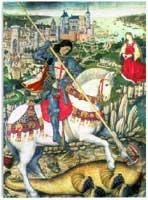
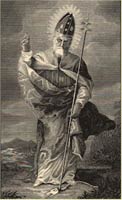
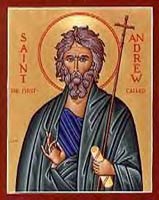 Ye shall destroy their alters, break their images, and cut down their groves. Exod. 34:14
Ye shall destroy their alters, break their images, and cut down their groves. Exod. 34:14
Ye shall utterly destroy all the places wherein the nations which ye shall possess served their gods, upon the high mountains, and upon the hills, and under every green tree: And ye shall overthrow their alters, and break their pillars, and burn their groves with fire; and ye shall hew down the craven images of their gods, and destroy the names of them out of that place. Duet. 12:2, 3.
If there be found among you . . . man or woman, that hath . . . served other gods, and worshipped them, either the sun, or moon, or any of the host of heaven, which I have not commanded . . . then shalt thou bring forth that man or that woman . . . and shalt stone them with stones till they die.
Deut. 17:2-5


Waves of immigrants, conquerors, and saints have effectively annihilated Pagan culture and the Temple of Isis in England.
Resurrect Isis. Let the Goddess lead us out of the dark ages of greed and war, and into a new age of enlightenment.
|
Reader responses are invited. |
Return to Home Page . . . Return to Table of Contents Hub
Links to related topic pages:
Sunwing . . . Ice Age . . . First Kingdom . . . Tower of Babel . . .
Alphabet Page B . . . Alphabet Page I